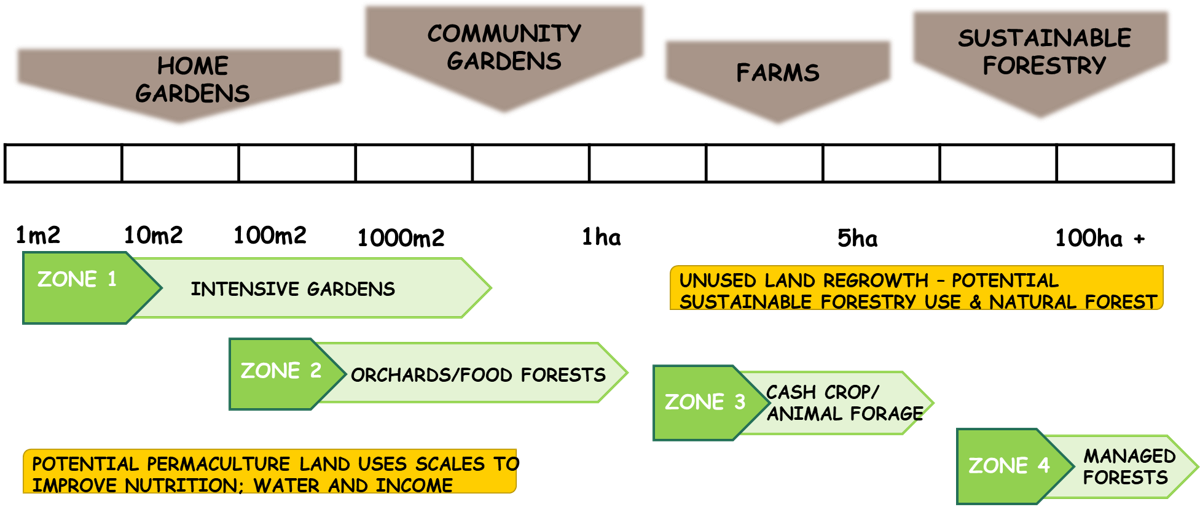Permaculture powered community development
Sustainability | 21 September 2023

I don’t know about you, but when permaculture was suggested to me a technique for community development I had some doubts but having seen Edge5 Permaculture in action I am now a convert. The Edge5 way uses an integrated approach to design, combining the ecological processes of land, plants, animals and climate into highly productive systems resulting in stronger and healthier communities. The approach is practical and hands-on, encourages peer-to-peer learning, starts at the backdoor with intensive kitchen gardens before building to larger scale strategies for water-harvesting, sustainable farming (crops, trees and animals) and agro-forestry.
So why look to permaculture (or agriculture-based techniques more generally) in the first place?
Taking the slo-framework as the starting point, company action to support / encourage / facilitate local development is a given. When used strategically community projects can reduce short term risk, enhance a reputation and contribute to a sustainable future. Another given is that a mine is a one-time, limited-life non-renewable resource. With the right attitude and approach the mine (or any other business for that matter) has the capability to generate opportunities for human, social and economic development right across its life-cycle. We also know that without the mine (or another business driven catalyst) local communities have a number of natural resources available to them from which to create sustainable self-reliance - land (soil), the climate – sun and water (energy), plants and animals, human skills and knowledge and community dynamics. Lastly, we know that community development projects have the best chance of being successful if they build on what is in place. Taking all this into consideration, I would make the case that building on existing local natural resources and leaving stable, healthy, self-reliant rural communities with water security; affordable and reliable sources of nutritious, locally produced food and productive natural and managed landscapes is a legacy worth aspiring to and is a result that permaculture can deliver when well-implemented.
What might a well-implemented project look like I hear you ask?
If it was me, I would start early and small. My first step would be to rewatch Ernesto Sirolli's TEDtalk as a reminder of the risk of failure if I am not actually responding to a local demand. Having done this, and confirmed the demand is real, I'd aim to establish a small pilot to run over a full growing season in one or two local communities with 15-30 women from each village. Ideally, I’d space things out over three rounds. I’d use the first to assess motivation, identify and teach easy to apply techniques and skills that resonate with the locals and look for potential champions and future peer educators. I'd use the second and third rounds to monitor up-take, establish demonstration gardens, do some peer educator training and work out the scope and budget for a wider roll-out. and write up either a close-out report (if not going further) or a funding justification if I think it has legs. Getting the local government agricultural extension officers involved and onboard at this early stage would a plus for long-term sustainability. If the interest and demand is there upscaling could take the form of expansion to bringing in additional villages or to working with larger footprints or both. Farms and orchards, school gardens (even better if linked to a feeding programme) and agro-forestry could each be part of the mix, tailored to site-specific needs and budgets. Imagine if you can a closure legacy of a forest of fully grown commercial timber, to be harvested to provide on-going community investment funding. Wouldn’t that be something?
If your vision doesn't extend quite so far there are plenty of other community benefits to be had - skills and confidence to shape the landscape to harvest and store water and to reduce erosion; skills and confidence to restore and sustain the soil food web, biomass and structure of productive soils and create a secure local food supply; more food on the table; a more balanced and nutritious diet; better health – particularly for women and children - and the opportunity to earn income from any surplus production. Equally important are the benefits for you and your company - a fit-for-purpose, low-cost scalable solution tied to investment decisions delivering tangible benefits, building trust and leave a legacy of valuable life-skills and knowledge. As a bonus if you are into the SDGs as a development framework permaculture should push some buttons.
However you want to look at it you could do worse than spending a few minutes to do some research and decide for yourself if permaculture needs to be part of your community development mix. And if you're still not sure, or you have some other ideas, get in touch - either with a comment on the blog or through the contact page.
Post a Comment